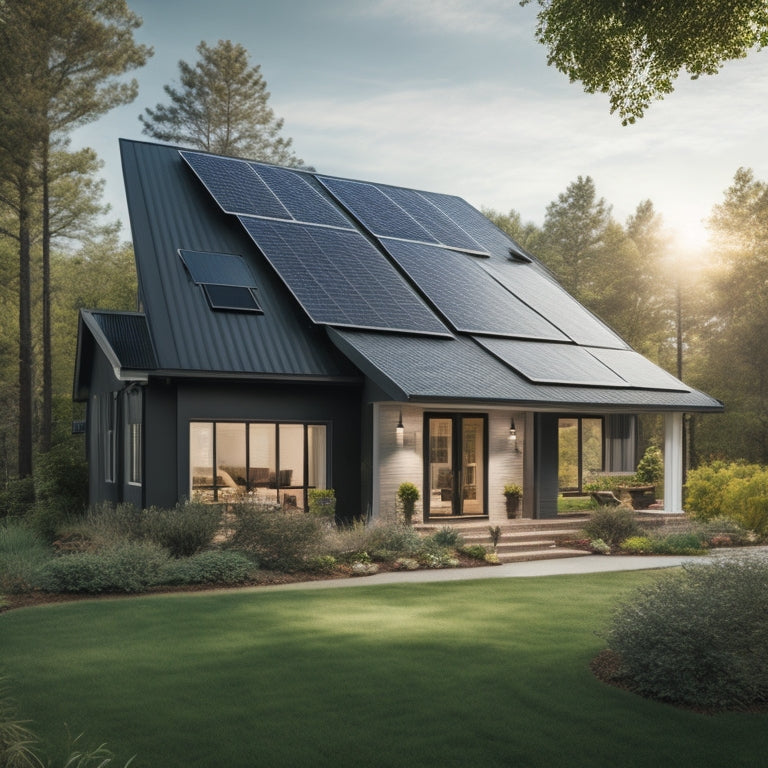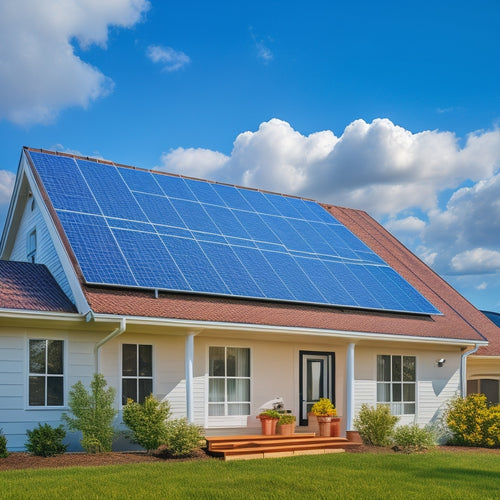
Mounting Solar Panels for Home Energy Independence
Share
You're taking the first step towards utilizing the power of solar energy to achieve home energy independence by mounting solar panels. When installing roof-mounted systems, you'll need to assess your roof type to determine installation techniques and accommodations. For ground-mounted options, selecting the right racking system based on site and energy goals is essential. You'll also need to take into account tracking systems, mounts, and accessories for ideal energy production. From fixed tilt to dual axis tracking, each option has its advantages and challenges. As you investigate these considerations, you'll uncover the perfect solution for your home energy independence, and the details that follow will help you get there.
Overview
- Roof-mounted solar panels offer energy savings and reduced environmental impact, but roof type evaluation is crucial for determining installation techniques.
- Ground-mounted systems require selection of an appropriate racking system based on site and energy goals, considering structural and soil stability factors.
- Adjustable tilt and dual axis tracking systems enhance energy efficiency, but installation may face challenges, and regular maintenance is necessary for peak performance.
- Solar panel orientation and tracking significantly affect energy output, and optimization is essential through conducting shading analysis and advanced installation techniques.
- DIY solar panel installation kits offer cost-effective solutions, but compliance with local regulations must be verified, and aesthetic integration with the roof design is important.
Roof-Mounted Solar Panel Systems
Most homeowners opt for roof-mounted solar panel systems, which involve installing solar panels directly onto your existing roof. This setup offers numerous solar panel benefits, including energy savings and a reduced environmental impact.
When it comes to installation techniques, it's vital to evaluate your roof type, as some materials may require special accommodations. Aesthetic considerations, such as panel color and arrangement, can also be customized to your preferences.
To guarantee proper integration of components, familiarize yourself with solar panel system components for peak performance. Be sure to research local regulations and financing options before installation.
Proper maintenance tips, like regular cleaning, will guarantee peak system performance. Correct system sizing is fundamental to maximize energy production and minimize costs.
With a well-designed roof-mounted system, you'll be well on your way to achieving energy independence.
Ground-Mounted Solar Panel Options
When you opt for ground-mounted solar panels, you'll need to decide on a racking system that suits your site and energy goals.
You'll have three primary options to evaluate: fixed tilt racking systems, which offer a cost-effective and simple solution; adjustable tilt options, which allow for seasonal adjustments to maximize energy production; and dual axis tracking systems, which actively track the sun's movement for peak energy harvesting.
Investing in high-efficiency solar charging solutions with advanced MPPT technology can further enhance energy independence.
Fixed Tilt Racking Systems
About 75% of residential solar installations utilize fixed tilt racking systems, which provide a straightforward and cost-effective solution for ground-mounted solar panel options.
As you consider this option, you'll want to weigh the fixed tilt advantages, such as lower upfront costs and easier installation, against the fixed tilt disadvantages, like reduced energy efficiency due to a non-ideal angle.
Since off-grid solar systems enable renewable energy independence and greatly reduce carbon footprints renewable energy independence, it's crucial to enhance your system's performance.
When installing, follow guidelines that prioritize structural considerations, like foundation type and soil stability, and choose materials that guarantee durability.
Regular maintenance and inspections will help prevent issues.
Conduct a thorough site assessment to confirm ideal placement, and consider the aesthetic impact on your property.
A detailed cost analysis will help you determine if fixed tilt racking systems are the right choice for your path to home energy independence.
Adjustable Tilt Options
Two out of every five homeowners who opt for ground-mounted solar panels choose adjustable tilt options, which offer superior energy efficiency compared to fixed tilt systems.
You'll benefit from adjustable tilt options as they allow you to enhance your solar panel's tilt angle according to seasonal changes, maximizing energy production.
Installation challenges may arise due to weather considerations, but adjustable tilt options can mitigate these issues. Unlike fixed tilt systems, adjustable tilt options can accommodate varying roof pitches, guaranteeing a secure and efficient installation.
Additionally, you'll appreciate the aesthetic appeal of adjustable tilt options, which can be adjusted to blend in with your home's design.
Remember to follow local regulations and maintenance tips to maintain peak performance and extend the lifespan of your solar panels.
Dual Axis Tracking
This advanced ground-mounted solar panel option, dual axis tracking, takes energy efficiency to the next level by allowing your solar panels to move flexibly in response to the sun's position.
You'll maximize your solar angle throughout the day, enhancing energy production. However, dual axis tracking comes with installation challenges, including complex site assessments and higher upfront costs.
To guarantee peak performance, regular maintenance tips include cleaning the tracking system and performing software updates.
While the cost implications are significant, the long-term benefits of increased energy efficiency and reduced environmental impact make it worthwhile.
Weather resistance is also a key consideration, as the tracking technology must withstand various climates.
With performance monitoring, you'll be able to track your system's effectiveness and make adjustments as needed.
Solar Panel Tracking Systems
You're likely aware that the orientation of your solar panels greatly impacts their energy output.
By optimizing their angle and direction, you can maximize your energy harvest.
A solar panel tracking system enables you to do just that, actively adjusting your panels to capture the most energy from the sun throughout the day.
Panel Orientation Matters
Ideal panel orientation is crucial for maximizing energy output, as even slight deviations from the perfect angle can lead to significant energy losses.
You'll want to enhance your panel's sunlight exposure by adjusting for seasonal changes, considering your roof's pitch, and accounting for your geographic location.
Conduct a thorough shading analysis to identify potential obstructions.
When installing your solar panels, employ advanced installation techniques that prioritize panel efficiency.
Regular maintenance practices will guarantee superior energy production over the long term.
Maximizing Energy Harvest
Beyond enhancing panel orientation, utilizing maximum energy from the sun requires advanced tracking systems that actively adjust to the sun's movement.
You'll want to take into account solar panel tracking systems that enhance energy efficiency through harvest optimization. These systems guarantee maximum sunlight exposure by adjusting to the sun's position throughout the day, while also accounting for shading analysis and seasonal adjustments.
Weather factors, such as wind and snow loads, are also included. Proper installation techniques and inverter selection are vital for peak performance.
Regular maintenance practices, like cleaning and inspection, will confirm your system operates at peak efficiency. When paired with battery storage, you'll be able to store excess energy for later use, further enhancing your energy independence.
Adjustable Solar Panel Mounts
How much flexibility do you need from your solar panel installation? Adjustable solar panel mounts provide the answer.
These mounts allow for adjustments in tilt and angle to optimize energy harvest throughout the year. They guarantee solar panel durability by withstanding various weather conditions, while installation considerations like mounting surface compatibility and load bearing capacity are also taken into account.
Aesthetic integration is maintained with sleek designs that blend with your roof. Maintenance requirements are minimal, and system flexibility enables you to adapt to changing environmental conditions.
Be certain to check local regulations before installation to verify compliance.
DIY Solar Panel Mounting Kits
You're considering taking a hands-on approach to solar panel installation, and DIY solar panel mounting kits can be a cost-effective solution. With a DIY installation, you'll reap significant cost savings by avoiding labor costs.
However, it's vital to select materials that maintain structural integrity and comply with local regulations. Weather considerations, such as wind and snow loads, must also be factored in. Aesthetically, the kit should blend seamlessly with your roof's design.
For a successful installation, follow the manufacturer's instructions and take necessary safety precautions. Additionally, invest in the right installation tools to guarantee a secure and efficient setup.
Flush Mount Solar Panel Racks
When opting for a DIY solar panel mounting kit, selecting the right racking system is essential to guarantee a secure and efficient installation. Flush mount solar panel racks are a popular choice for their sleek, low-profile design that blends seamlessly with your roof. These racks are ideal for asphalt shingle, metal, and tile roofs, offering a durable and weather-resistant installation.
| Roof Type | Mounting Materials | Aesthetic Considerations |
|---|---|---|
| Asphalt Shingle | Aluminum or stainless steel | Low-profile design, black anodized finish |
| Metal | Stainless steel or galvanized steel | Sleek, modern look, corrosion-resistant |
| Tile | Aluminum or stainless steel | Discreet, roof-penetrating design, weather-resistant |
Flush mount racks require careful load calculations and code compliance to guarantee a safe and efficient installation. Regular maintenance tips include inspecting the racks for signs of wear and tear, assuring proper energy efficiency. A thorough cost analysis will help you determine the best value for your investment.
Solar Panel Mounting Accessories Needed
Three essential components make up a complete solar panel mounting system: the racking system, the mounting accessories, and the solar panels themselves.
To guarantee a secure and efficient installation, you'll need specific mounting accessories. These include mounting hardware such as clamps, brackets, and fasteners, which must be chosen based on structural considerations, weather resistance, and load calculations.
You'll also need to take into account installation techniques, maintenance tips, and safety guidelines to guarantee a hassle-free setup.
Additionally, think about the aesthetic impact of your installation, as well as local regulations and cost analysis.
Frequently Asked Questions
Can I Install Solar Panels on a Metal or Tile Roof?
You can install solar panels on metal or tile roofs, but be prepared to address unique challenges; metal roofs require specialized clamps, while tile roofs demand careful tile removal and replacement to guarantee watertight installation.
Do Solar Panels Work Well in Areas With Heavy Shading?
Curiously, you're not alone in dealing with shady spots! You'll find that solar panels can still work in areas with heavy shading, but you'll need to take into account shading solutions to minimize performance impacts, ensuring ideal energy harvesting.
Are Solar Panels Durable Enough to Withstand Harsh Weather?
You're wondering if solar panels can handle harsh weather? Rest assured, you'll find they're built to last, boasting a 25-30 year solar panel lifespan and extreme weather resilience, withstanding hail, strong winds, and heavy snow loads, giving you peace of mind.
Can I Expand My Solar Panel System in the Future?
You'll likely need to guarantee your initial system's future capacity and system compatibility to expand your solar panel setup in the future, which requires careful planning and consideration of your energy needs and system design.
Will My Solar Panels Be Covered Under My Homeowner's Insurance?
As you bask in the warmth of independence, you're wise to wonder if your solar panels are shielded from unexpected storms; typically, your homeowner's insurance policy covers them, but be certain to review your coverage limits to guarantee you're protected from financial shocks.
Ready to Buy
You've made it! You've maneuvered through the world of solar panel mounting options and are now ready to utilize the power of the sun. Like a conductor leading an orchestra, you'll be in control of your energy independence. With the right mounting system, you'll be generating clean energy in no time. So, take the reins and ride the wave of renewable energy – your wallet and the planet will thank you!
Related Posts
-

Cost of Solar Panel Installation
You can expect to pay between $15,000 and $30,000 or more for a typical solar panel installation, depending on the sy...
-

Fastest Solar Chargers for Emergency Power
When choosing the fastest solar chargers for emergency power, you need to focus on features like rapid charging capab...
-

Solar Powered Lights for Sustainable Home Decor
Solar-powered lights offer a stylish and eco-friendly way to enhance your home decor. They capture sunlight, converti...


